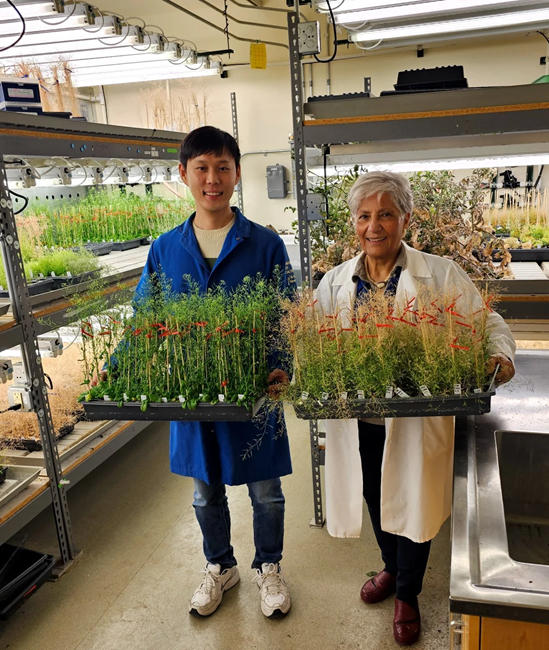For more than a century, scientists have been aware of a certain organelle found in plant cells. However, that organelle's crucial function in aging has only recently been uncovered by UC Riverside scientists.
 Researchers Heeseung Choi and Katie Dehesh are holding young, green, old, and yellow Arabidopsis plants in the laboratory. Image Credit: Katie Dehesh/UCR
Researchers Heeseung Choi and Katie Dehesh are holding young, green, old, and yellow Arabidopsis plants in the laboratory. Image Credit: Katie Dehesh/UCR
Initially, the goal of the study was to get a broader understanding of the portions of plant cells that regulate the reactions of plants to stress caused by various factors such as infections, excessive salt, or inadequate light. By chance, they discovered that this organelle and a protein that keeps it functioning regulate whether plants survive being left in the dark for extended periods of time.
The research team was ecstatic about this discovery, detailed in Nature Plants, as they had not anticipated it.
For us, this finding is a big deal. For the first time, we have defined the profound importance of an organelle in the cell that was not previously implicated in the aging process.”
Katie Dehesh, Professor, Department of Molecular Biochemistry, University of California, Riverside
The Golgi body, an organelle of several cup-shaped sacs coated with membranes, is sometimes compared to a stack of deflated balloons or some dropped lasagna. It arranges different molecules throughout the cell and ensures they end up where they should.
Golgi are like the post office of the cell. They package and send out proteins and lipids to where they are needed, and a damaged Golgi can create confusion and trouble in the cell’s activities, affecting how it works and stays healthy.”
Heeseung Choi, Researcher, Department of Botany and Plant Sciences, University of California, Riverside
The COG protein is the postal worker if the Golgi is the post office. The motion of tiny sac "envelopes" that move other molecules around the cell is regulated and coordinated by this protein.
Furthermore, COG facilitates the attachment of sugars by Golgi bodies to other proteins or lipids prior to their translocation within the cell. Glycosylation is a sugar alteration that is essential to numerous biological functions, including the immune system.
The study team altered some plants to prevent them from producing COG to learn more about how it impacts plant cells. The altered plants developed perfectly and were indistinguishable from untreated plants under typical growing circumstances.
On the other hand, when plants lack light, they are unable to convert sunlight into sugar, which is needed for growth. The mutant, COG-free plants' leaves turned yellow, wrinkly, and thin when they were exposed to too much darkness; these were symptoms that the plants were dying.
Choi added, “In the dark, the COG mutants showed signs of aging that typically appear in wild, unmodified plants around day nine. But in the mutants, these signs manifested in just three days.”
The plants were quickly revived by reversing the mutation and introducing the COG protein. Dehesh said, “It is like nothing happened to them once we reversed the mutation.”
Choi further added, “These responses highlight the critical importance of the COG protein and normal Golgi function in stress management.”
The fact that Golgi bodies are present in the cells of all eukaryotic species, including humans and plants, adds to the enthusiasm around this discovery. Plants can now be used as a platform to investigate the nuances of the Golgi's function in human aging. The research team is therefore preparing additional investigations into the molecular mechanisms underlying the findings of this study.
Not only does our research advance our knowledge about how plants age, but it could also provide crucial clues about aging in humans; when the COG protein complex does not work properly, it might make our cells age faster, just like what we saw in plants when they lacked light. This breakthrough could have far-reaching implications for the study of aging and age-related diseases.”
Katie Dehesh, Professor, Department of Molecular Biochemistry, University of California, Riverside
Source:
Journal reference:
Choi, H.-S., et.al., (2023). COG-imposed Golgi functional integrity determines the onset of dark-induced senescence. Nature Plants. doi.org/10.1038/s41477-023-01545-3